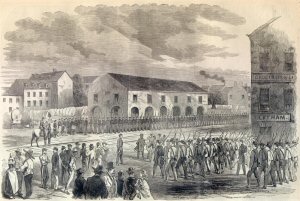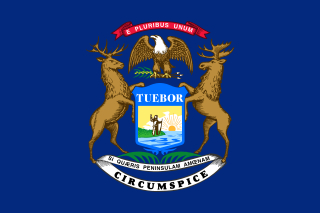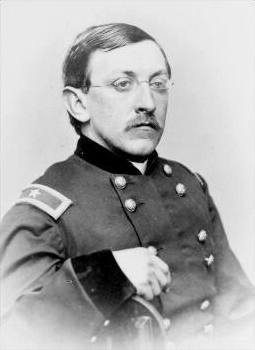
The Army of the Shenandoah was a field army of the Union Army active during the American Civil War. First organized as the Department of the Shenandoah in 1861 and then disbanded in early 1862, the army became most effective after its recreation on August 1, 1864 under the command of Philip Sheridan. The army's actions during the Valley campaigns of 1864 rendered the Shenandoah Valley of Virginia unable to produce foodstuffs for the Confederate States Army, a condition which would hasten the conclusion of the American Civil War.

The Battle of Cedar Creek, or Battle of Belle Grove, was fought on October 19, 1864, during the American Civil War. The fighting took place in the Shenandoah Valley of Northern Virginia, near Cedar Creek, Middletown, and the Valley Pike. During the morning, Lieutenant General Jubal Early appeared to have a victory for his Confederate army, as he captured over 1,000 prisoners and over 20 artillery pieces while forcing seven enemy infantry divisions to fall back. The Union army, led by Major General Philip Sheridan, rallied in late afternoon and drove away Early's men. In addition to recapturing all of their own artillery seized in the morning, Sheridan's forces captured most of Early's artillery and wagons.

The Second Battle of Winchester was fought between June 13 and June 15, 1863, in Frederick County and Winchester, Virginia as part of the Gettysburg Campaign during the American Civil War. As Confederate Lieutenant General Richard S. Ewell moved north through the Shenandoah Valley in the direction of Pennsylvania, his corps defeated the Union Army garrison commanded by Major General Robert H. Milroy, capturing Winchester and numerous Union prisoners.

The Third Battle of Winchester, also known as the Battle of Opequon or Battle of Opequon Creek, was an American Civil War battle fought near Winchester, Virginia, on September 19, 1864. Union Army Major General Philip Sheridan defeated Confederate Army Lieutenant General Jubal Early in one of the largest, bloodiest, and most important battles in the Shenandoah Valley. Among the 5,000 Union casualties were one general killed and three wounded. The casualty rate for the Confederates was high: about 4,000 of 15,500. Two Confederate generals were killed and four were wounded. Participants in the battle included two future presidents of the United States, two future governors of Virginia, a former vice president of the United States, and a colonel whose grandson, George S. Patton, became a famous general in World War II.
The 14th New Hampshire Infantry Regiment was an infantry regiment that participated in the American Civil War. It was the last three-year regiment raised in New Hampshire, serving from September 24, 1862, to July 8, 1865. Carroll Davidson Wright was one of its regimental leaders.

Thomas Casimer Devin was a United States Army officer and general. He commanded Union cavalry during the American Civil War and during the Indian Wars.
The 9th West Virginia Infantry Regiment was an infantry regiment that served in the Union Army during the American Civil War.

The city of Winchester, Virginia, and the surrounding area, were the site of numerous battles during the American Civil War, as contending armies strove to control the lower Shenandoah Valley. Winchester changed hands more often than any other Confederate city.

The 5th Michigan Cavalry Regiment was a cavalry regiment that served in the Union Army during the American Civil War. It was a part of the famed Michigan Brigade, commanded for a time by Brigadier General George Armstrong Custer.

John Baillie McIntosh was a Union Army brigadier general during the American Civil War. His brother, James M. McIntosh, served as a Confederate general until he was killed in the Battle of Pea Ridge.

George Henry Chapman was an American sailor, newspaper editor, lawyer, and soldier. He served in the United States Navy during the Mexican–American War and as a Union Army general during the American Civil War. Later in life he was a judge and a state legislator.
The 1st New Hampshire Cavalry Regiment was a cavalry regiment that served in the Union Army during the American Civil War.
17th Indiana Battery Light Artillery was an artillery battery that served in the Union Army during the American Civil War.
The 1st Connecticut Cavalry Regiment was a cavalry regiment that served in the Union Army during the American Civil War.
John Tribe was a Union Army soldier in the American Civil War who received the U.S. military's highest decoration, the Medal of Honor.

The 5th New York Cavalry Regiment, also known as the 5th Regiment New York Volunteer Cavalry and nicknamed the "1st Ira Harris Guards", was a cavalry regiment of the Union Army during the American Civil War. The regiment had a good fighting reputation, and had important roles in the Battle of Hanover and the Battle of the Wilderness. It was present at nearly 175 battles and skirmishes, including Gettysburg, Opequon, and Cedar Creek. A majority of its fighting was in Virginia.

Friend Smith Rutherford was an American military officer who was colonel and posthumously appointed brigadier general in the Union Army during the American Civil War. He commanded the 97th Illinois Infantry Regiment during the Vicksburg campaign. On June 18, 1864, President Abraham Lincoln nominated Rutherford for appointment to the grade of brigadier general of volunteers and the United States Senate confirmed the appointment on June 28, 1864. Rutherford's appointment was dated June 27, 1864, and it was to rank from June 28, 1864. His appointment was made and commission issued without knowledge of his death on June 20, 1864. Since Rutherford had died, the confirmation technically could not be given and the commission could not become effective. Nonetheless, several sources list Rutherford as a Union Army general, although historian Ezra Warner does not.
The Battle of Camp Davies was a skirmish during the American Civil War on November 22, 1863, near a Union Army camp about six miles south of Corinth, Mississippi. A 70-man detachment of the 1st Regiment Alabama Cavalry (Union), commanded by Major Francis L. Cramer, drove off a 150-man Confederate force of the 16th Battalion, Mississippi Cavalry State Troops, commanded by Major Thomas W. Ham, and killed at least 4 Confederate soldiers, while suffering two severely wounded troopers. This action is the only engagement recorded as occurring at or near Camp Davies in major sources on American Civil War battles. Other similar engagements in the vicinity of Corinth in 1863 may have occurred near Camp Davies.

The 6th New York Cavalry Regiment, also known as the 6th Regiment New York Volunteer Cavalry and nicknamed the "2nd Ira Harris Guards", was a cavalry regiment of the Union Army during the American Civil War. The majority of its fighting was in Virginia as part of the Army of the Potomac.

The 14th Pennsylvania Cavalry Regiment was a cavalry regiment of the Union Army during the American Civil War. Most of its fighting happened in the last half of 1863 and full year 1864. The regiment fought mainly in West Virginia and Virginia, often as part of a brigade or division commanded by Brigadier General William W. Averell and later Brigadier General William Powell.












